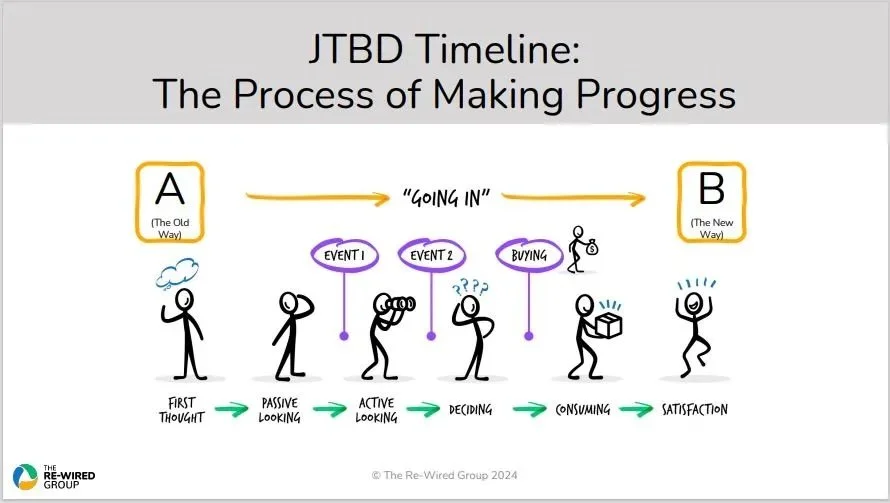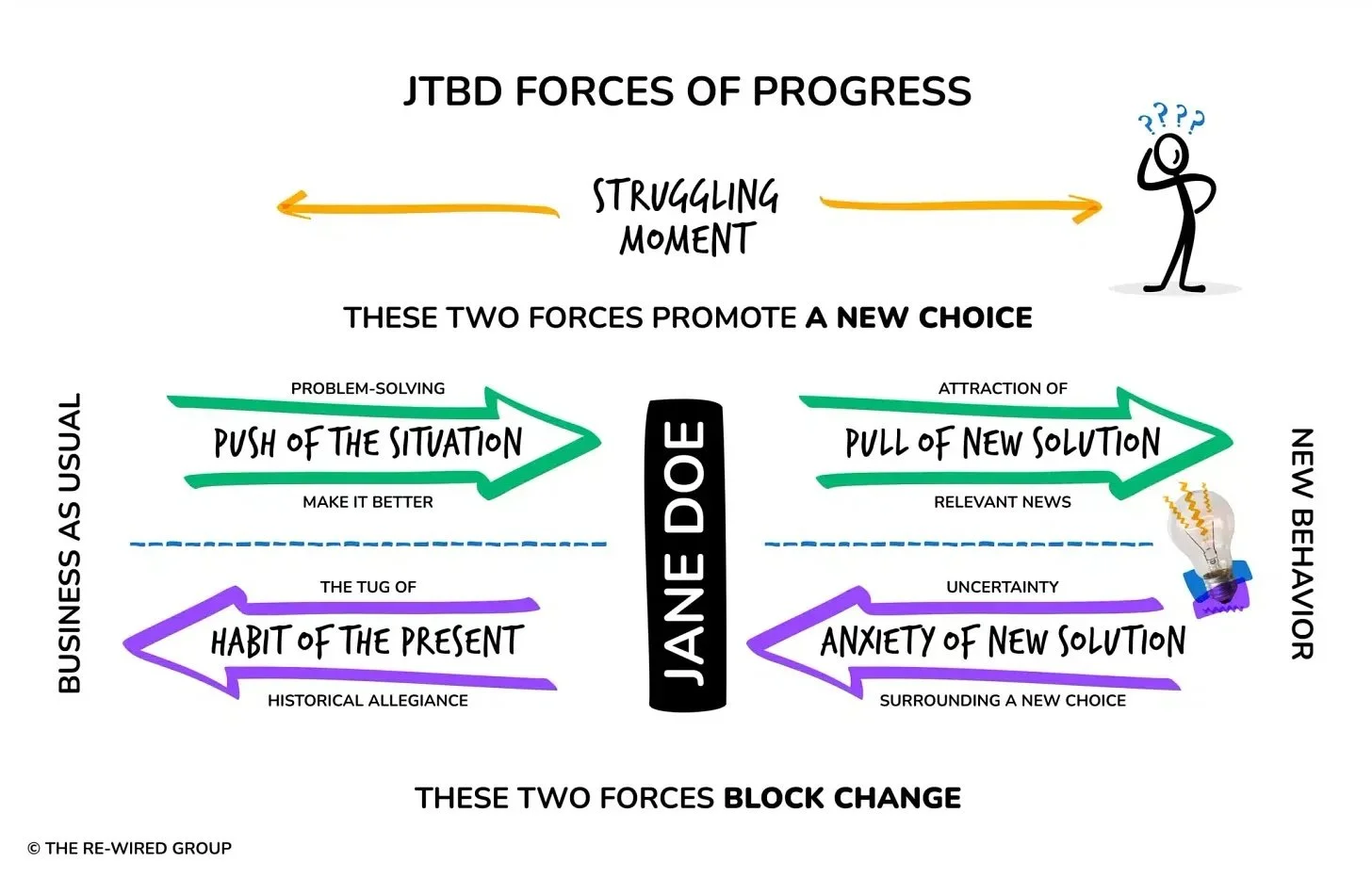Want to Increase Customer Acquisition and Retention? Understand Jobs to Be Done.
JTBD is a powerful approach that provides way more value than being customer centric. Want to know how to message, sell, support, and design profitable products that will get hired? Read on!
Since meeting Bob Moesta and Eckhart Boehme, I’ve been thinking about the value of Jobs To Be Done beyond simple customer discovery.
The theory can be used to understand why customers buy, stay, pay and even bring other customers!
It could also be applied to how we as humans respond to change (but that’s another article….coming soon. Subscribe so you don’t miss it).
There is value here beyond designing the product itself.
If you want your sales teams to increase conversions, understand the customer context, their job to be done and the importance of the Big Hire.
If you want your customers to stay and continue to pay, understand their context, job to be done and the importance of the many Little Hires.
Want to differentiate and create a product that practically sells itself (product led growth anyone?), understand your customer’s jobs, their hiring and firing criteria and their desired outcome.
Even understanding how customers talk about their problems, the impact of a desirable outcome, what their push and pull factors are invaluable in marketing, messaging and positioning products.
"Jobs to Be Done" (JTBD) as a term is only 21 years old.
Customers lining up for your product because you’ve understood the Job to be Done.
It was first introduced by Clayton Christensen in his book "The Innovator's Solution," published in 2003. Christensen, a professor at Harvard Business School, developed this framework as part of his work on disruptive innovation, which he began exploring in the late 1990s. The JTBD framework has since been expanded and popularised by other innovators and thinkers, including Bob Moesta and Eckhart Boehme.
It is only in the last few years that the real power of Job to Be done is being understood.
Want to conduct competitor analysis?
Start with jobs to be done interviews with customers and find out how else they may solve their problem and their experience in hiring those alternatives.
Haven’t heard of “Jobs To Be Done” (JTBD)?
Let me explain…
Jobs to Be Done: The Core Concept
JTBD asserts that customers "hire" products or services to achieve specific goals or solve particular problems. This approach shifts the emphasis from the product itself to the deeper needs and objectives of the customer. Understanding JTBD involves recognising the functional, emotional, and social elements of the "job" the customer wants to get done.
The Struggling Moment: Catalyst for Innovation
A key element in JTBD theory is the customer's struggling moment—a point of friction or difficulty that prompts the search for a solution. This struggling moment reveals unmet needs and opportunities for new products, services or experiences. Recognising and addressing these moments can lead to solutions that deeply resonate with customers.
Demand-Side Selling: Aligning with Customer Needs
Demand-side selling, as articulated by Moesta, focuses on understanding and catering to the customer's job rather than pushing products. This approach aligns the sales process with the customer journey and their struggling moment through the JTBD lens.
Acquisition: The Big Hire
The acquisition phase involves attracting customers by addressing their immediate and primary needs, known as the Big Hire. The Big Hire refers to the main job the customer seeks to accomplish when they first adopt a product or service. For example, a fitness app's Big Hire might be helping users lose weight. Understanding and effectively communicating how a product solves this primary problem is crucial for acquiring new customers.
Engagement and Retention: The Little Hires
Engagement and retention involve keeping customers invested in the product by continually fulfilling their needs through multiple Little Hires. Little Hires are the ongoing tasks or secondary jobs that keep customers returning to the product. In the fitness app example, Little Hires might include providing daily workout suggestions, tracking progress, and offering nutritional advice. These consistent, smaller fulfillments ensure the product remains valuable over time, fostering long-term engagement and loyalty.
The Steps to Reveal Your Customers’s Jobs
Viewing the customer journey through the JTBD lens means your Sales, Marketing, Support and Product Teams are armed with the data needed to profitably grow the product.
These are:
1. Context
Context encompasses the broader circumstances in a person's life, giving a big-picture view of their situation. It’s their current experience as they see it. For instance, an elderly couple may decide to downsize from a large family home to a condominium, motivated by the desire to simplify their living situation and reduce maintenance responsibilities.
They may be triggered to consider downsizing while reading the obituaries.
For a Marketer, this represents an opportunity to consider advertising the product somewhere they may never have considered before.
2. Struggling Moments
A struggling moment is when someone realises something could be better, driving the desire for change. It's the emotional drive pushing for change. Innovation thrives on identifying these struggling moments. For example, the couple may feel overwhelmed by the upkeep of their large house and the effort required to maintain a garden, leading them to seek a more manageable living space. Their first thought may have been triggered by a friend's funeral and watching that friend's partner organise their affairs and move to a smaller home.
Understanding this struggling moment and the language of these users can be used to inform marketing material, messaging and positioning. Starting with the problem in the words of your target users.
Recognising these moments of struggle helps product teams pinpoint areas where improvements are needed, highlighting the gap between the current state and a desired outcome that can be incorporated into the product roadmap.
3. Pushes and Pulls
Pushes are the circumstances that create the struggling moment, such as the physical and emotional strain of maintaining a large property.
Pulls are the attractive features of a new solution, like the convenience and ease of living in a modern, low-maintenance condominium.
Understanding this internal struggle within your users can be used to inform the sales and marketing approach.
4. Anxieties and Habits
Anxieties are concerns about adopting a new solution, such as worries about adjusting to a smaller living space, what to do with the huge dining table and leaving behind a familiar neighbourhood.
Habits are established behaviours, like the routine of gardening or hosting family gatherings, that must be changed. Habits are comfortable behaviours that create a resistance to change.
Knowing these objections to change, the anxieties and habits, allows for the creation of objection handling messaging that your sales and marketing teams can use in their messaging.
5. Desired Outcomes
Desired outcomes are the ideal results people wish to achieve by switching to a new solution. These outcomes reflect what satisfaction looks like. For the downsizing couple, this might be enjoying a more relaxed lifestyle, with more time for hobbies and less time spent on home maintenance.
Knowing your customers desired outcomes, means you can design product metrics for success that align with them. When customer’s desired outcomes are met, they’re more likely to stay, pay and refer other customers to your product.
6. Hiring and Firing Criteria
Hiring criteria are the essential features a solution must have, like a condominium offering amenities such as a communal garden and a nearby park for walks.
Firing criteria are aspects that would cause customers to abandon the solution, such as inadequate storage space or poor community facilities.
Knowing your customers' hiring criteria means you can zone in on developing and prioritising those experiences into your product that they value the most and quieten the noise of having to build everything that product teams are often faced with. This is your true minimum viable product.
Likewise knowing what can cause your product to be fired becomes a list of experiences to avoid within the product, sales and support process.
7. Key Trade-offs
Key trade-offs involve what a person is willing to give up to achieve their goal.
The couple might trade their spacious backyard for the convenience of a well-maintained communal area.
This is where Value exchange is. Knowing what your customers are willing to pay for your product, how they value your product and end to end experience is an invaluable input into your pricing strategy.
8. Qualities of a Job
Each "job" has fundamental qualities it must meet. These essential attributes are non-negotiable. For the downsizing couple, it may be that the condominium must be secure, easy to maintain, and offer a sense of community. Understanding these essential attributes helps reformulate the product to better fit customer needs.
Leveraging Customer Discovery Interviews for Business Success
JTBD customer discovery interviews are an understated yet powerful way to understand unmet customer needs (jobs) and can reveal opportunities across the customer journey that you may have never considered.
Increase Conversions for Sales: By understanding the specific jobs customers are trying to get done, sales teams can tailor their pitches to highlight how their product uniquely solves these problems. This alignment with customer needs can lead to higher conversion rates as prospects see the direct relevance and value of the product.
Improve Retention: Continuous fulfilment of both the Big Hire and the multiple Little Hires ensures that customers remain satisfied and loyal. By regularly conducting JTBD interviews, businesses can stay attuned to evolving customer needs and adjust their offerings accordingly, thereby enhancing retention rates.
Uncover the Language Customers Use for Marketing and Messaging: JTBD interviews reveal the words and phrases customers use when describing their problems and the solutions they seek. This insight allows marketing teams to craft messages that resonate more deeply with the target audience, using language that mirrors their thoughts and feelings.
Reveal the Most Valued Job for Product Development Focus: Identifying the primary job that customers value the most helps product development teams prioritise features and functionalities. Focusing on this MVP (Minimum Viable Product) ensures that the product addresses the most critical customer needs first, increasing its chances of success in the market.
Uncover Alternatives and Competitors from the Customer's Perspective: Interviews often reveal what alternatives customers consider and why. This information is crucial for understanding the competitive landscape and positioning the product more effectively against competitors. It also highlights indirect competitors that may not be immediately obvious.
Expose Experiences that Motivate Customers to Stay, Pay, and Refer: Understanding the specific experiences that drive customer satisfaction and loyalty can guide the design of features and services that enhance these experiences. Knowing what motivates customers to stay, pay, and refer others helps businesses create a more compelling value proposition and foster a loyal customer base.
Hiring and Firing Criteria
Understanding why customers "hire" or "fire" a product is crucial. Hiring criteria include the functional and emotional jobs the product fulfils, ease of use, and the value it provides. Firing criteria, on the other hand, often involve unmet expectations, difficulty of use, or better alternatives. Businesses need to continuously assess these criteria to ensure their products remain relevant and valuable. But not all hires are equal - enter the “Big Hire” and the many “Little Hires”
Little Hire vs. Big Hires
Do you know the difference between the “Big Hire” and the “Little Hire”?
Crucial in understanding how a customer makes progress to get their job done.
🔹 The Big Hire: The big hire happens when a customer decides to purchase your product. It's the moment of commitment – buying a cleaning product, signing up for software, or subscribing to a service. This decision is significant, but it's just the beginning.
🔹 The Little Hire: The little hire occurs when the customer actually uses the product. It's when they spray the cleaner, utilise the software features, or engage with your service. This is where real value is created, and it’s critical for ensuring customer satisfaction and retention.
They both matter.
You may think that once the Big Hire is made, you can go celebrate that win.
But as Bob Moesta insightfully puts it, real value is found in the Little Hire.
This is where customers experience the tradeoffs and performance of the product firsthand. Understanding these nuances helps us create products that not only attract buyers but also retain users.
Focusing solely on the little hire without considering the big hire can be problematic. We might develop fantastic products that fail to attract customers initially. Both hires are essential, and understanding their differences and the tradeoffs involved is key.
Key Insights:
Holistic Focus: Success lies in both attracting customers (big hire) and ensuring they find value in usage (little hire).
Context Matters: Understanding how and when customers use your product is vital.
Balance Trade-Offs: A great product must balance initial appeal with ongoing value.
Real value is created in the little hire, but both are essential for success.
Need to better understand your Customer Jobs?
And improve conversion, retention, engagement, revenue and more? I can help. Drop me an email at irene@phronesisadvisory.com
Are you new to Product Management and want to learn from me?
I created a Course. for people new to Product Management.
Aligned it with the Learning Outcomes created by Product greats like Jeff Patton and others. Had it certified by the globally recognised ICAgile.
Choose to spend 2 days learning from me - either face to face or via Zoom - with ICAgile Certified Professional in Product Management (ICP-PDM).
And if you’re looking for a sneaky discount, send me an email at irene@phronesisadvisory.com



